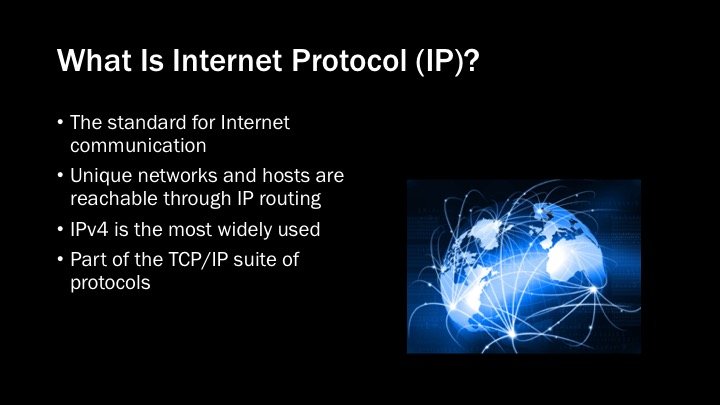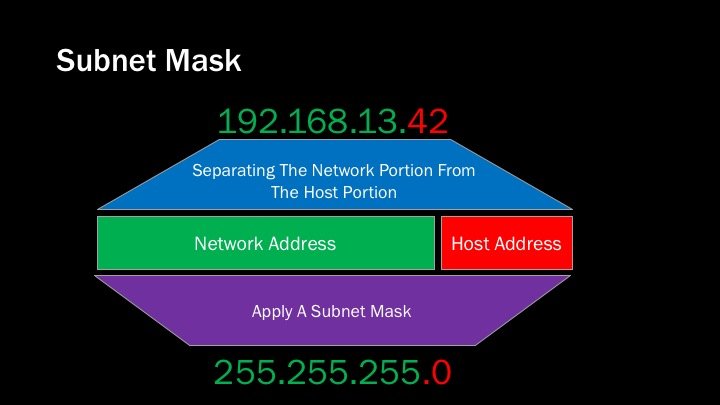I am currently working on a video course, and I've decided to post my slides and scripts here on STEEM as I go along. I appreciate any feedback or suggestions, or if you are new to the world of computer networking, I hope you enjoy them! Here is part 1 of a multi-part series.

Hello, welcome to my deep dive course on addressing and subnetting for IP Version 4. In this course, we will take a look at what an IP address is, how to determine your own IP address, as well as how the IP address functions as a basic building block of the Internet. IP version 4 is still the predominant addressing scheme used on the Internet, even though the use of IPv6 is growing. I will discuss IP version 6 in a future deep dive course.

IP addresses facilitate communication on the Internet, meaning two devices, such as computers, must have a unique public Internet address in order to communicate. These unique addresses are reachable on the public internet through the use of routing protocols.
IP version 4 is the most widely used scheme, but IP version 6 is emerging due to the depletion of IP version 4 address space. This course focuses on the legacy IP version, IP version 4.
IP is part of the larger TCP / IP suite of protocols, including TCP, and ICMP.

An IP address represents a single unique device on the Internet, such a computer, smart phone, or website. If you connect to the Internet, at some point your communication is being identified to the outside world using a unique Internet address.
An IP address contains two parts, a network address and a host address. In modern networks it is difficult to determine which part is which. A subnet mask is used to identify what the network address is, and what the host address is. More on that later.

There are two primary conceptual models for how computer networks operate, these are the OSI model developed by the International Standards Organization (ISO), and the TCP/IP model that predates it. You may hear of an IP address, protocol, or device referred to as being Layer 3. This is because the IP protocol maps directly to the Network layer, or layer 3 of the OSI model. IP also maps directly to the Internet layer of the TCP/IP Model, which was developed as part of the TCP/IP protocol suite. The details of these models is not the focus of this course, but it’s important you know what is meant by a ‘Layer 3 Address, protocol, or device’ and where they fit into these models, as many documentation sources will refer to them.

IP Version 4 was first proposed by the US Defense Advanced Research Projects agency, or DARPA in 1980 via Request for Comments (RFC) 760. It was standardized via RFC 791 in 1981. It was deployed in 1983 on the ARPANET, which later because the modern Internet.
IP Version 6 is the upgrade to IPv4. It was proposed in 1995 via RFC 1883, and standardized in 1998 via RFC 2460. It was created to address the issue of IPv4 address space exhaustion. Its deployment has been slow due to technologies such as Network Address Translation (NAT). More on NAT later.
RFCs are the technical documentation for computer networking managed by the Internet Engineering Task Force (IETF). If you are interested in learning more information about a subject, you can just enter RFC and the number into a search engine or the IETF website.

An IP address consists of two parts, these are the network address, and the host address.
In the old days you could simply look at the IP address and intuitively separate the network from the host address. This was due to fixed network classes. With the advent of subnetting, which we will talk about later, you need some mechanism to tell which is which. This mechanism is called the subnet mask.

The subnet mask is a similarly looking number to an IP address. Here we have an example of the IP address 192.168.13.42, with a subnet mask of 255.255.255.0. The network portion of the subnet mask indicated in green corresponds to the network portion of the IP address also indicated in green. The host portion of the subnet mask indicated in red corresponds to the host portion indicated in red. Let’s take a closer look at how an IP address and subnet mask is built.

Here is that same IP address. An IP address and subnet mask are 32-bit numbers expressed in dotted decimal notation. This means that it is divided into 4 8-bit octets separated by a decimal point. To fully understand how an IP address is utilized, and how a subnet mask interacts to divide the network address from the host address, we need to learn some basic binary math, which we will cover in the next section.
Ahh good old networking, my stepping stone into programming :)
Haha, I went in the other direction and have been trying to loop back around. It's been slow going.
The basic but, it is the essential! ;)
With out this better don't go further.
Well done!
Posted using Partiko Android
Thanks, first of a series so will get more advanced.
Posted using Partiko Android
👍 nice!
Posted using Partiko Android
Thank you joshman! You've just received an upvote of 57% by tommyknockers!
Learn how I will upvote each and every one of your posts
Please come visit me to see my daily report detailing my current upvote power and how much I'm currently upvoting.